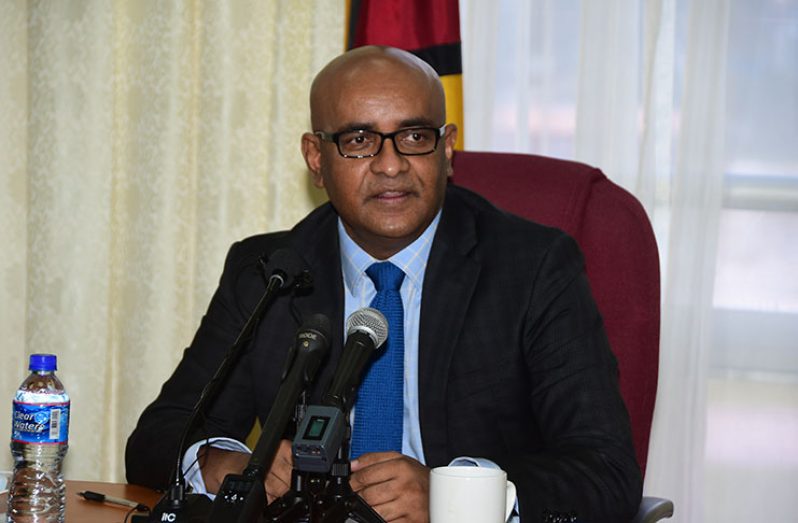– industry must benefit investors but significantly benefit Guyanese, says VP Jagdeo
By Navendra Seoraj
ONGOING negotiations between the government and oil giants, ExxonMobil, on the company’s Field Development Plan (FDP) for the Payara project, while important to the country’s development as an oil nation, does not determine the government’s position or opportunities in the oil and gas sector, said Vice-President, Bharrat Jagdeo.
The Payara project, located in the eastern half of the Stabroek Block, is expected to see the drilling of up to 45 development wells which could take up to five years, with drilling initially pegged to begin in 2020 and initial production by early 2023.
The project marks EEPGL’s third field development in the Stabroek block and targets 180,000 to 220,000 barrels of oil per day, with anticipation to produce approximately 5,700,000 to 6,600,000 barrels of crude oil per month.
“Government does not see Payara as a make-or-break,” said Vice-President Jagdeo during a press briefing on Monday.
A review of the Payara Development Project was previously conducted by the Bayphase Oil and Gas Consultants contracted by the Department of Energy (DoE) under the previous administration.
The new People’s Progressive Party Civic (PPP/C) administration, however, decided to review the work already undertaken by the DoE to ensure that the interests of all Guyanese are protected and are in keeping with international transparency and accountability standards. The current review is being done by a team of international experts, headed by Canadian Queen’s Counsel, Alison Redford.
Minister of Natural Resources, Vickram Bharrat, had told this publication that a team of legal and technical experts from the DoE and a team from ExxonMobil are discussing the draft licence for the Payara project.
As it is now, there are issues related to the Payara project that the government and ExxonMobil do not see eye-to-eye on, but Jagdeo said active negotiations are still ongoing .
“We see this as a continuum… Exxon (Mobil) will not disappear tomorrow, and the Payara licence is not the only opportunity to get what the President (Dr. Irfaan Ali) said and what the PPP/C campaigned on, and that is, an industry that benefits the investor, but significantly benefits the people of Guyana, through jobs, business opportunities and so on,” said the vice-president.
President Ali had said government wants to strike a balance by ensuring the country gets more for local content, brings natural gas to shore and ensure the lives of all Guyanese are improved significantly.
Government’s ability to address those areas of concern is not limited to the Payara negotiations, as there will be further opportunities to talk about local content and local content legislation and also discuss the development of gas fields and the prices for gas, among other things, said Vice-President Jagdeo.
HAS TO DO MORE
Training opportunities for locals will also be on cards, as the vice-president believes that ExxonMobil has to do more for training of Guyanese.
Although there is no local content legislation, ExxonMobil was reported to have spent over G$14 billion in the first half of 2020, and has utilised more than 600 Guyanese suppliers for services ranging from foodstuff to engineering.
Guyana Chronicle reported that ExxonMobil trained more than 50 Guyanese in countries such as Brazil, Canada, Singapore, Trinidad, United Arab Emirates and the United States, to gain hands-on oil and gas experience to leverage in Guyana.
According to ExxonMobil’s Public and Government Affairs Adviser, Janelle Persaud, more than 2,000 Guyanese are supporting ExxonMobil Guyana’s operations, representing 55 per cent of the total workforce.
ExxonMobil Guyana’s direct workforce now stands at 155, more than 50 per cent of which are Guyanese.
She noted that capacity building is an ongoing process for ExxonMobil Guyana and its direct contractors, with more than 100,000 hours of training provided to Guyanese staff as of the first half of 2020.
The company’s expenditures and operations are, however, still to be fully audited, as Vice-President Jagdeo said government will aggressively pursue costs incurred by the company.
“Exploration cost up to 2017 are now being audited, so there are large opportunities to agree or disagree with cost…we see areas where we do not believe that expenditure made now or before are part of cost oil and should be there,” he said.
REMAIN AGGRESSIVE
Jagdeo promised that government will remain aggressive in its negotiations with any company, especially ExxonMobil.
The vice-president referred to reports that the oil company’s global position has dimished, so investment dollars are scarce. He, however, said government is not threatened by that.
Bloomberg had reported that ExxonMobil, Pfizer and Raytheon Technologies were kicked out of the Dow Jones Industrial Average, as part of the stock benchmark’s biggest reshuffling in seven years.
According to the report, while any change to the Dow is notable, the ejection of ExxonMobil — the world’s biggest company as recently as 2011 — marks a particularly stunning fall from grace, reflecting the decline of commodity companies in the American economy. Worth $525 billion in 2007 and more than $450 billion as recently 2014, the stock had fallen in four of six years before 2020 and is down another 40 per cent since January.
Despite those constraints, Guyana has already received US$140 million from the sale of crude, which is being produced by ExxonMobil’s Liza phase one development.
ExxonMobil is now firmly established in Guyana, operating an office in Georgetown with numerous ongoing exploration and development operations offshore. ExxonMobil Guyana has made 18 discoveries since May 2015 and began production in December 2019 from the Liza Phase one development project.
The company is the operator of the Stabroek, Canje and Kaieteur Blocks offshore Guyana. Since 2015, ExxonMobil has increased its estimated recoverable resource base in Guyana to more than eight billion oil-equivalent barrels.




.png)









